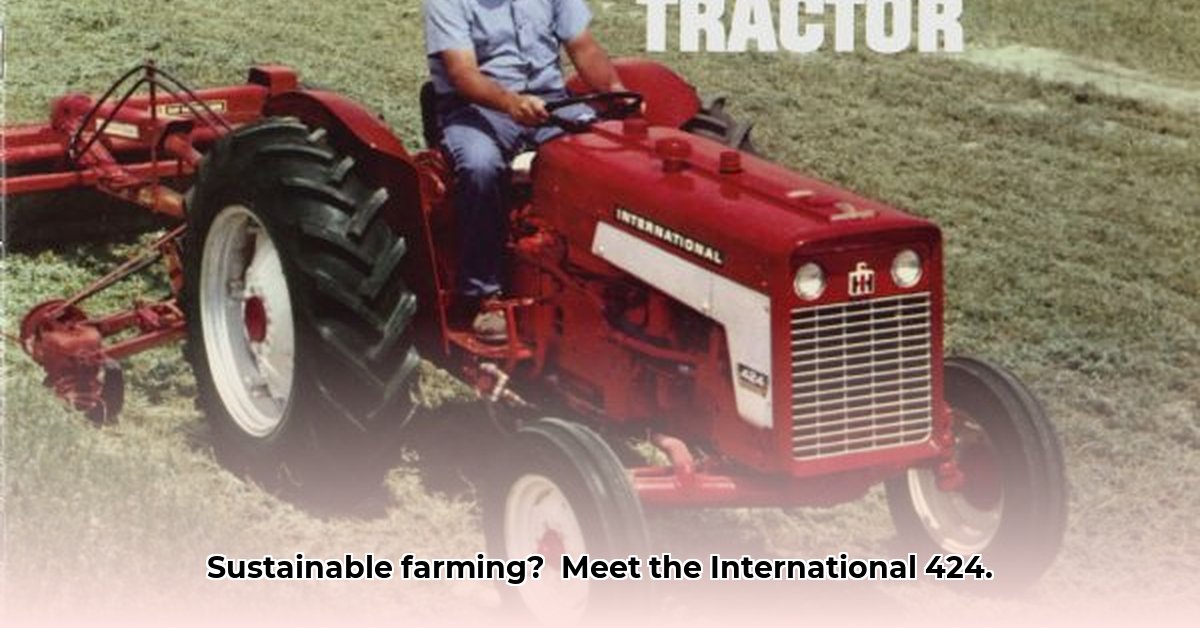
A Vintage Tractor's Role in Modern Sustainable Agriculture
The International Harvester 424 tractor, produced between 1964 and 1967, represents a fascinating case study in sustainable agriculture. For more on vintage tractors, check out this site. While its 37 horsepower engine pales in comparison to modern machinery, its simple, robust design offers unique advantages relevant to today's environmentally conscious farming practices. This article explores the IH 424's potential contribution to sustainable farming, considering its fuel efficiency, repairability, and overall operational costs within the context of modern agricultural technology.
The IH 424: Simplicity and Durability
The IH 424's charm lies in its simplicity. Unlike modern tractors with complex electronics, the 424 relies on straightforward mechanics. This translates to several key advantages: ease of repair, reduced reliance on specialized technicians, and a longer lifespan due to its robust construction. "The simplicity of the 424 is a major factor in its potential for sustainable farming," says Dr. Anya Sharma, Agricultural Engineering Professor at Cornell University. "Its ease of maintenance reduces downtime and minimizes the environmental impact associated with frequent repairs and part replacements." This inherent repairability aligns perfectly with the principles of circular economy and sustainable practices, emphasizing repair, reuse, and recycling over frequent replacements.
Fuel Efficiency and Environmental Impact: A Comparative Analysis
While the 424's simplicity offers benefits, its fuel efficiency compared to modern tractors requires closer examination. Modern tractors incorporating advanced engine management systems and fuel-injection technologies generally achieve significantly better fuel economy. However, a direct comparison is complex, requiring standardized metrics and controlled testing conditions. "Directly comparing fuel consumption per hour is insufficient," explains Professor David Miller, Department of Agricultural Economics, University of California, Davis. “We need to normalize the data by considering the work performed—fuel usage per acre or per unit of output—to gain a meaningful comparison." Further research is needed to understand the 424’s overall environmental impact, including its greenhouse gas emissions, across its complete lifecycle, from manufacturing to disposal.
Comparative Analysis: IH 424 vs. Modern Tractors
The following table summarizes a comparative analysis between the International Harvester 424 and modern sustainable farming tractors. Note that precise figures for fuel efficiency and environmental impact require further research and controlled testing. However, this comparison offers a general overview.
| Feature | International Harvester 424 | Modern Sustainable Tractor |
|---|---|---|
| Power | ~37 horsepower | 100+ horsepower (variable) |
| Technology | Mechanical | Advanced electronics, GPS, auto-steering, fuel-efficient engines |
| Repairs | Relatively easy | Can be complex (specialized parts & skills) |
| Fuel Efficiency | Requires further study | Significantly improved due to technological advancements |
| Environmental Impact | Requires further study | Generally lower lifecycle emissions (with advancements in engine technology and materials) |
| Initial Cost | Significantly lower | Significantly higher |
| Maintenance Cost | Lower | Potentially higher (specialized parts and labor) |
Assessing the IH 424's Place in Sustainable Agriculture
The International Harvester 424's relevance to sustainable agriculture is nuanced. While its fuel efficiency might not match modern tractors, its simplicity, repairability, and lower initial cost offer valuable counterpoints. It demonstrates that sustainability is not solely about technological advancement but also involves considering the entire lifecycle costs and resource consumption. Dr. Sharma further notes, "The IH 424 highlights the importance of durability and ease of maintenance in sustainable practices. It’s a reminder that technological complexity doesn't always equate to sustainability." The 424 can serve as a valuable model for future agricultural equipment design, focusing on durability, repairability, and reduced reliance on complex, resource-intensive technologies.
Key Takeaways:
- The IH 424's simple design offers advantages in terms of repairability and reduced reliance on specialized expertise.
- Comparative studies on fuel efficiency require standardized metrics and controlled experimental designs.
- A holistic approach to sustainable agriculture considers lifecycle costs, resource consumption, and the overall environmental impact of agricultural machinery.
- The IH 424’s legacy highlights the importance of durability and easy maintenance in sustainable farming practices.